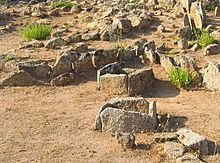|
|
|
|
Li MuriMegalithic Cemetery
|
||||||||||||||||||
|
|
|
Images (click to view fullsize) |
|









|
Fieldnotes |
|
|
23 May 2008 Close to Li Lolghi is the small megalithic cemetery of Li Muri, consisting of five cairns with cists. Carefully constructed and equally carefully restored, it didn't overwhelm me, in fact I hardly felt whelmed at all, but I was very interested to see other tombs in the region which weren't tombi di giganti. |
 Posted by Jane
Posted by Jane30th May 2008ce Edited 30th May 2008ce |
|
Li Muri is about a ten minute drive from Li Longhi. Drive past the site and park in the car park on the hill. Walk back up the hill and buy a ticket at the small hut. Once again I was able to use the guide who also spoke excellent English and had a deep love of this site. This Neolithic necropolis should have a ring of familiarity about it to anyone who has read about or visited British prehistoric burial sites. The site is not large but it is full to the brim with archaeology. The site is neatly 'tucked in' amongst numerous rocky outcrops with views over the surrounding valleys. Basically what you have here are five cist burials, four of the burials date to about 4500BP, the fifth cist dates to a later pre-Nuraghic culture. There are also a number of standing stones or Betyls, and small cist-like boxes that 'were used for offerings'. The four Neolithic cists are surrounded by a number of small concentric circles and were originally covered by an earth mound or cairn with only the outer kerb showing. The cists were orientated north–south and when excavated yielded a rich crop of distinctive grave goods including obsidian arrowheads, polished axes, mace heads, flint knives, pottery, soapstone necklaces and a steatite bowl which may be of Cretan origin. The fifth, and later, cist is aligned roughly east-west and was also covered by a cairn. My guide was extremely enthusiastic about the site and went to great lengths to explain many aspects of Sardinian prehistory including the trade in Obsidian throughout the Mediterranean. Sardinian obsidian was the best in Europe and Galluran obsidian was the best in Sardinia. She was also very keen on Irish archaeology having just spent seven months living in Galway. One thing that struck me about the site was a large outcrop of weathered granite on the margins of the site. For me the rock almost seemed part of the site and on closer inspection I noticed a number of weathered depressions and natural bowls within its structure. I tried to discuss this with the guide and how the people who built the monument could have easily chosen a rock-free site in the adjacent field. But she only smiled and said that we can only discuss the facts of the site. I did however detect a knowing look in her smile or maybe I was kidding myself, perhaps she just pitied me for my wide eyed ramblings. She did inform me that the local rocks, some of which are weathered into the most bizarre shapes, contained rock shelters. Some of these shelters had been excavated and yielded early pottery. The necropolis of Li Muri reminded me of home. There are definite parallels with sites on the North York Moors such as Obtrusch and round barrows and cairns in many other parts of our islands. This post appears as part of the weblog entry Scratching the Surface in Sardinia Pt1.
|
 Posted by fitzcoraldo
Posted by fitzcoraldo3rd October 2007ce Edited 3rd October 2007ce |
|
From the fork in the road where the directions to this site and Li Lolghi split, it was 1.2km to the car park and information building (closed when we got there) just past the site, and about 120 metres up a gentle incline to get back to the site itself which has a gate and wooden hut at its entrance. The site has wooden posts and rails to keep people off the stones, and viewing platforms similar to those we'd seen at Coddu Vecchju. There are 5 cists; 4 of these have a menhir and stone slabs arranged around them to form a circle; cist number 5 to the far left on my panoramic photo has an incomplete circle with an open front. This is believed to be the oldest site on the island, at around 4000 BCE. Tickets are 5 euros to visit both here and Li Lolghi, payable at the information office just down the slope - the guide was at the circles when we arrived and we followed her down to pay after our visit. As usual for the "pay" sites, there were toilets, and a range of info, drinks and snacks on sale. This post appears as part of the weblog entry Sardinian Seconds
|
28th September 2007ce Edited 2nd October 2007ce |
Links |
|
Li Muri leaflet |
28th September 2007ce |

